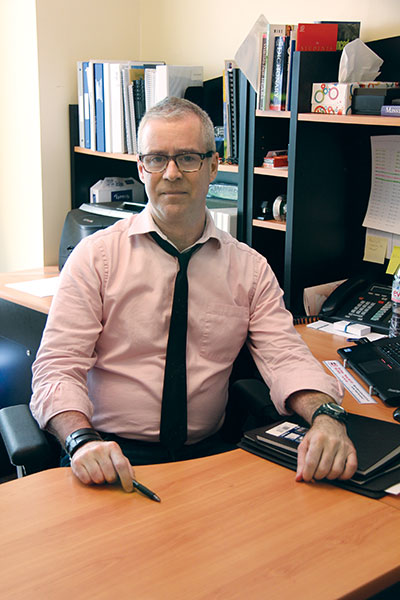
Features
Collaboration
Practice
Onward and upward
When the Ontario Board of Regents first regulated the practice of massage in the province of Ontario in 1919, it was in recognition of massage therapy as a form of health care.
July 4, 2014 By Mari-Len De
When the Ontario Board of Regents first regulated the practice of massage in the province of Ontario in 1919, it was in recognition of massage therapy as a form of health care. Today, nearly a century later, Ontario continues to play a leadership role in propelling the profession further up in the health-care chain.
 |
|
| Massage therapists have a role to play in overall efforts toward disease prevention.
|
Although massage therapy has evolved significantly through the decades, debate over professional identity still remains: relaxation versus therapeutic massage, spa setting versus health care setting. Disagreements notwithstanding, and as far as the Ontario regulatory college is concerned, massage therapy remains within the health-care realm.
“I think there are still some conversations going on within the profession as to how they identify themselves,” says Corinne Flitton, registrar and CEO at the College of Massage Therapists of Ontario (CMTO). “The college sees them as regulated health professionals, so we expect our vision is that they should enter the current health-care system.”
Despite being one of the most highly utilized forms of complementary and alternative health services, massage therapy’s recognition as a necessary component of the overall health-care system remains wanting, and those in the leadership roles within the profession are continuously trying to change that for the better.
Proactive approach
The Registered Massage Therapists’ Association of Ontario (RMTAO), an organization of about 5,000 registered massage therapists, is among those working to elevate the profession. To accomplish this, RMTAO believes massage therapy needs to be part of a larger conversation on improving Ontario’s overall health-care system – one that focuses on proactive prevention and wellness promotion.
“What needs to be talked about in Ontario is that we need to look at a new health-care model,” says Andrew Lewarne, executive director and CEO of the RMTAO. “At the moment we’re reactive. Every provincial health plan seems reactive.”
Ontario Ministry of Health says 25 per cent of health-care costs are due to preventable illnesses. In 2010-2011, more than 271,000 hospital emergency room visits could have been treated in alternative primary care settings – at lower costs.
The Ontario government estimates that if no changes are made to improve the health-care system today, health-care costs will increase by $24 billion by the year 2030.
Lewarne believes prevention is key to sustaining the country’s health-care model. Massage therapists and other alternative and complementary health practitioners will be the ideal partners for pursuing this goal of wellness and prevention.
“That means we need to be partnering up, we need to be able to turn around to the gatekeeper physicians, the family doctor, and say, ‘here’s what we can do, here’s how we can do it and if you want to get some really good responses to what’s walking into your office, refer them to me.’”
However, for this to succeed, Lewarne says alternative and complementary health services need to be partially supported by government.
RMTAO is engaging the legislative leadership to propose a tax credit for Ontarians who use the services of complementary and alternative health practitioners – covered under the Health Professions Act – for preventative health care.
Under the current system, only health expense receipts in excess of $2,171 (for 2014) or three per cent of net income, whichever is lesser, can be claimed for federal tax credit
The RMTAO believes this current system is “reactionary as opposed to proactive.” A tax credit for preventative health care, such as what the RMTAO proposes, is more proactive and less costly, effectively easing the financial pressure on an already cash-strapped health-care system in the long run.
Lewarne sees this as a win-win for both massage therapy professionals in Ontario and the provincial health-care system – as preventative health care will become more accessible for Ontarians, putting less strain on hospitals and acute care services.
“Massage therapy, which is one of the most widely used among the complementary therapies, if you make it more available then you know that people are going to use it and when they use it… the credibility of the profession is going to go up,” Lewarne says.
Credibility
A constant challenge that is certainly not unique to Ontario’s more than 11,000 RMTs, as it is faced by practitioners in other provinces, is a bruised credibility with the insurance industry. It’s the consequence of malicious and fraudulent acts of a few unscrupulous practitioners that have effectively managed to stain the profession in the eyes of insurers. The situation has been improving significantly in recent years, however, as practitioners across the country, through their respective professional associations, have taken an active role in engaging the insurance industry and educating them on professional practices in hopes of aiding the reduction of insurance fraud.
 |
|
| As the new executive director and CEO of the RMTAO, Andrew Lewarne engages stakeholders in an effort to propel the profession forward.
|
Most recently, the RMTAO has engaged the Canadian Health Care Anti-fraud Association to ensure the insurance industry is aware of the steps and systems in place to help
prevent fraud.
“These kinds of clarifications are really important and they need to happen,” says Lewarne. “And as that happens, you will find that the responsiveness both to the insurance industry and from the insurance industry is going to go up.”
Ontario is also pursuing means of enabling regulated health-care practitioners, including massage therapists, to help prevent fraud. The Financial Services Commission of Ontario is getting ready to implement a professional credential tracker tool that allows health-care practitioners to do an online check to see which clinics or health facilities are using their information to submit auto insurance claims.
This new system, when implemented, will allow practitioners to have better control of their professional information and an easier way to determine potential fraud.
“I suggested to the insurance industry that (the professional credential tracker) might not be a bad idea to put in place for the extended health-care industry,” Lewarne points out.
Education
Massage therapy training in 1935 was only offered in private schools and was completed in less than a year. In response to advances in medical trends, the curriculum was expanded to a two-year program in 1987, and then further expanded to a three-year program in the mid-90s.
Many in the profession would like to see education evolve even further into a degree program. Toronto’s Centennial College is one of them. Centennial offers a three-year advanced diploma program in massage therapy.
“(A degree program) is certainly a direction for our future,” says Lori Copeland, coordinator at Centennial’s faculty of massage therapy program. “We’re a regulated profession but we don’t need a degree. I think (having a degree) puts us on the map in health care.”
Although there has been no concrete advancement in instituting a degree program as of yet, the profession is currently working on the next big thing: national accreditation for massage therapy education.
The recently formed Massage Therapy Council for Accreditation seeks to establish national accreditation for massage therapy programs, in an effort to bring Canadian massage therapy schools up to national standards.
“Ontario is working as one stakeholder from the Federation of Massage Therapy Regulatory Authorities of Canada, the Canadian Massage Therapist Alliance and Canadian Council of Massage Therapy Schools to establish the accreditation agency and process,” explains CMTO’s Flitton, one of the council “founders” tasked with incorporating the accreditation council, among other things.
The standards to be instituted by the national accreditation council will be based on the Inter-jurisdictional Practice Competencies and Performance Indicators, developed and approved in 2012 by the three regulatory bodies for massage therapy: Ontario, B.C. and Newfoundland and Labrador
The accreditation council expects to commence the accreditation process by 2015, but many schools in Ontario have already began mapping their curriculum to the new entry-to-practice competencies document as early as 2013. This is largely due to the fact CMTO has announced it will begin testing for registration based on the new competency document in 2015.
When the competency document was released in 2012, massage therapy schools in Ontario begun mapping their curriculum to the new competency standards.
Centennial has been adjusting its massage therapy curriculum to meet the new standards. Copeland says it has not been a huge adjustment on the part of the school and she is confident the graduates will be able to write the new registration exam with success.
“The students and graduates who come from a program that has really taught to the inter-jurisdictional competencies will be accepted and recognized across the country once the word gets out there,” Copeland says.
Enabling professional mobility for massage therapists in the regulated provinces of Ontario, B.C. and Newfoundland and Labrador has already been in place since 2009, under the labour mobility provisions in Ontario’s Regulated Health Professions Act, according to Flitton.
CMTO facilitates the registration of RMTs coming to practice in Ontario from other regulated Canadian provinces, without any need for further assessment of their program of study in massage therapy.
The only thing that will be required of massage therapists from another province seeking registration in Ontario is evidence of good character from the Canadian jurisdiction where they practiced and successful completion of the CMTO’s jurisprudence examination.
Practice mobility is expected to further expand to other jurisdictions as national accreditation becomes fully operational.
Research
Research is another front that Ontario is actively pursuing. The CMTO provides funding for the Massage Therapy Research Fund, an annual national level research competition administered through the Canadian Interdisciplinary Network for Complementary and Alternative Medicine Research.
“CMTO wishes to encourage high quality research in massage therapy, particularly in relation to professionalization of massage therapy, for example, evidence based practice, collaboration with other health-care professionals, evaluation of MT practices, and massage therapy effectiveness, efficacy and safety,” says Flitton.
It is not just being able conduct research that is in vital need for the profession, however; it’s the ability to understand and evaluate the quality of scientific studies.
Research literacy, according to RMTAO’s Lewarne, is as vital as the research itself. “We need to actually have the research literacy – that’s what needs to happen. And that’s an educational component,” he says.
Expanding and developing massage therapy research will directly influence the profession’s credibility in the health-care arena. However, research should not be done at the expense of tradition, notes Lewarne, who is also a RMT.
“We have a huge tradition in massage therapy and it’s a tradition based on trust,” he explains. “At the end of the day it’s about touch, but the research needs to support the touch.”
Copeland and Lewarne agree that research will drive the profession forward, and so would making massage therapy education a degree program.
“It’s just becoming clear that we need to make that step, and part of the reason that I would like that step to be in place is because I want to have practitioners that are mature right out of the gate,” says Lewarne.
A degreed program would also propel more research in the field of massage therapy, says Copeland, and provide the foundation for advancing the profession’s role in disease prevention.
“As we get stronger in research and recognized as a degreed profession, then we start moving where we need to go, and that’s higher up in the health-care field,” Copeland says.
Mari-Len De Guzman is the editor of Massage Therapy Canada and Canadian Chiropractor magazines. Contact her at mdeguzman@annexweb.com.
Related articles in the Regional Focus series:
Western Canada (Spring 2014)
The regulation debate
Prairie Provinces (Fall 2014)
There’s an ad for that
Eastern Canada (Winter 2015)
To have and have not
Print this page